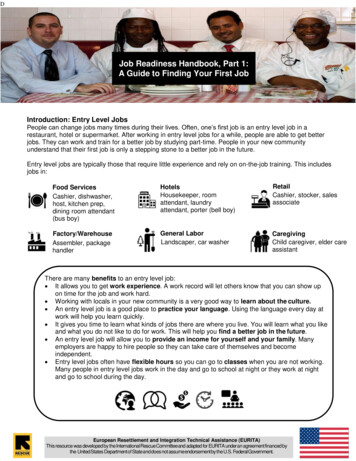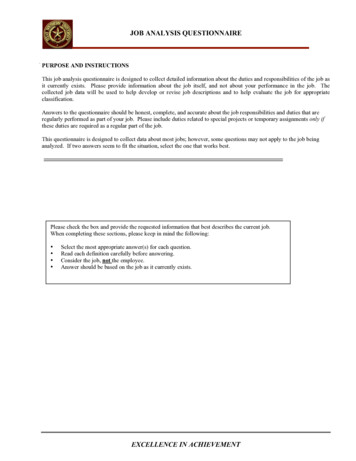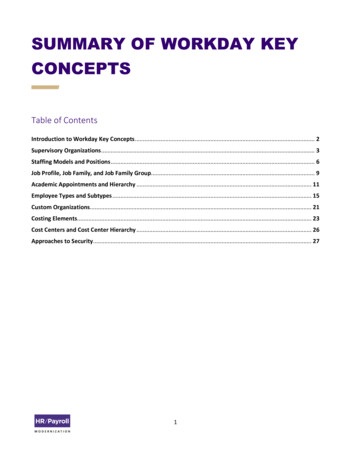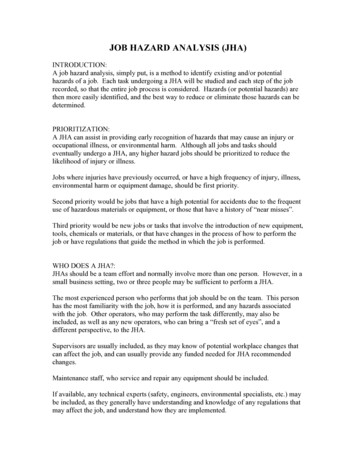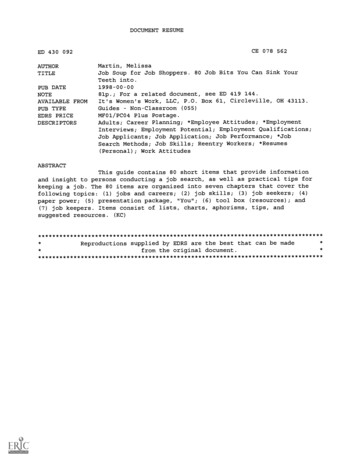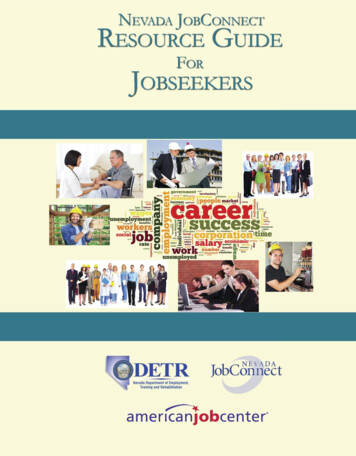
Transcription
2 - Resource Guide for Job SeekersintroDUCtioninSiDeIt should not come as a surprise that looking for work can be a lot of work,especially if you have not been in the job market for a while, or if you arechanging careers. If you need help putting together a résumé, and are notsure how to answer some questions on a job application, or are scared todeath at the prospect of a job interview, you have come to the right place. HereIntroduction2are some hints to make the job search less frightening and more productive.Dealing with Unemployment3Optimism, Confidence, and Energy are three of the most important emotionalExamine the Past4states for your reemployment efforts. An optimistic outlook will help your mindSetting Goals5NevadaJobConnect (NJC) Services6Hints for Job Seekers6Completing Job Applications7Creating a Master Application8Résumé Development9General Guidelines9focus on the positive aspects of situations. It is imperative that your consciousand subconscious minds are receptive to new ideas and opportunities.Successful people prepare themselves both mentally and emotionally foropportunities. What some people call “luck”, successful people call beingprepared when an opportunity presents itself. What happened yesterday isin the past, and has no influence on your future, unless you give it that power.Read, Read, and Read. Do you see a trend here? Read positive motivationalbooks, uplifting biographies, inspirational stories, and any other type ofliterature that leaves you feeling energized and refreshed. Fill your mind withgood positive thoughts and ideas. You will find yourself seeing things from aJob Seeker Do’s & Don’ts11Scannable Résumés12Online Application Tips12Résumé Do’s & Don’ts13your goal and are back to work. However, it is recommended that some dailyKeywords13positive reading be continued. This will ensure your attitude stays positivelyCreating Cover Letters14Cover Letter Do’s & Don’ts15Preparing for the Interview16Sample Interview Questions17Success Tips for the Interview17Types of Interviews17After the Interview Follow Up18Necessary Job Search Skills19Reasons People Don’t Get Hired20Ten Steps of a Job Search20Job Search Websites21Nevada 2-1-123Nevada JobConnect Career Centers24different perspective, more positive, more optimistic, and better able to faceany challenge that comes along. This positive mental state will also openyour eyes to previous unrecognized opportunities. It is recommended thatyou refrain from reading doom and gloom books until you have accomplishedcharged.Get out of the house. This activity brings its own excitement.Get outamong people, friends, mingle, network, talk to people, and create your ownopportunities. Any activity is better than no activity. Walk and exercise; learnto enjoy life again. A more positive and optimistic mental outlook will start withthese activities.family iSSUeSUnemployment affects everyone in your family. Do not isolateyourself, but rather talk to your family about how you are feeling orwhat you are doing. Have some family time and allow everyoneto voice their concerns and ideas. Ask for their assistance inconserving financial resources. By working through this together,you can build your family’s self-esteem, sense of competenceand trust in yourselves as a family unit.www.nevadajobconnect.com
Resource Guide for Job Seekers - 3StepS to taKe if yoUHave loSt yoUr JoBor finD yoUrSelf inneeD of employment1. File for Unemployment Insurance Compensation;for a Nevada claim you may file online at http://ui.nv.gov or call 702-486-0350 (Southern Nevada),775-684-0350 (Northern Nevada) or toll free 888890-8211.2. Prepare your résumé.3. Begin your job search and apply for jobs that meetyour qualifications. Remember to apply for morethan one job at a time. It may take some timeto move through all the steps from application toaccepting a position.4. Change the greeting on your home/cell answeringmachine to something short and professional. Anexample: “Hello this is the Smith residence, pleaseleave a detailed message with a contact name, thename of the company and a phone number whereyou can be reached. I will return your call as soonas possible.”5. Have a professional generic e-mail address justfor job search.6. Have paper and pen ready by each phone in thehouse. (For taking notes about a job interview)7. Prepare for interviews. Practice with friends orfamily. Make sure you are ready for any difficultquestions so you are not caught off guard. Onegreat way to do this is to type a list of potentialinterview questions along with bulleted answers.This will give you some great talking points.8. Attend any interviews offered.9. Prepare and mail thank you letters. This is animportant step of the process. It adds a greatpersonal touch and is a great opportunity toaddress some weaker aspects of your interview.10. Accept a job offer.www.nevadajobconnect.com
4 - Resource Guide for Job SeekersTake some time to think through the past. You needan accurate grasp of what has happened in order tofeel better about the future.Things done right at my previous job:1. (As an example to get you started: Developedand designed new training material for office.)2.3.Things that could have been done better/changes I need to make to do the job better:1. (Example: Need more training on excel spreadsheets - I will contact Nevada JobConnect, andsee if they have training classes I can attend.)2.3.Where to get help making these changes:1. (Example:I can go to my local NevadaJobConnect office and see if they have trainingavailable.)2.3.www.nevadajobconnect.com
Resource Guide for Job Seekers - 5Begin to Set goalSNow that you have dealt with the past, think about thefuture. Begin setting goals by asking yourself: How much do I need to earn? Can I afford to wait for the “perfect” job or do I need totake whatever comes along? What kind of work do I want to do? What may be some alternatives? What do I absolutely not want to do? Should I consider changing careers? Do I need more training? Should I relocate to where my skills are more indemand?Now that you have explored your strengths, preferencesand limitations, you can begin to set some long-termgoals. While it may take months to achieve your ultimateobjectives, they can be achieved by setting and meetingshort-term goals. Write down your goals and set deadlinesso you can track your progress. Goal writing sample includes:1.Long-term Goal: Find a new joba.Short-term Goal: Send out résumés to specific businessesI.II.Action: Draft three master versions of my résumé and a master cover letter1.Resources: (Samples from NJC resource center)2.Deadline: (Pick-a-date - give yourself 30 days)Action: Re-write résumés and cover letter based on feedback from qualifiedindividualsIII.1.Resources: (Choose 5-7 qualified people to proof read my résumé)2.Deadline: (Example: March 15)Get names, addresses, and phone numbers of individuals withinqualified businesses.IV.1.Resources: (Newspapers, phone book, Internet search)2.Deadline: (Example: April 13)Action: Mail résumé and cover letters to the specific contact within eachbusiness.1.Deadline: (Example: April 20)www.nevadajobconnect.com
6 - Resource Guide for Job SeekersnevaDa JoBConneCtNevada JobConnect offices are available statewideto assist your effort to find new employment. Ouroffices can also provide information on resourcesavailable in the community which can assist youwith training. Offices are staffed with workforceprofessionals who understand the local labor marketand who can provide you occupational guidance toassist your return to work. In addition each office canprovide the following services: Self-guided employment searchesReferral to available job openingsJob development and placement assistanceLabor Market InformationRésumé and cover letter assistancePhones and computer access to fileUnemployment Insurance claims and to accessemployment resourcesBusiness directory of local employersEmployment related workshops (i.e.,Interviewing Skills) when availablePrograms available at the NevadaJobConnect offices or through referralinclude the following:Employment Services Veterans Employment Services Career Enhancement Program Vocational Rehabilitation Services Trade Act Services Workforce Innovation and Opportunity Actservices Migrant and Seasonal Farmworker Services Work Opportunity Tax CreditHelpfUl HintS for JoB SeeKerSChoose Your Target Carefully: Put your time andenergy into opportunities that you are interestedin. You also want to focus on those that give youthe best chance of receiving an offer. Pick a fewcompanies you are interested in and pursue them,no matter if they have openings or not.Take a temporary position if freelancing is not anoption, consider interim staffing. No matter whatthe economy does, work still needs to get done.Many staffing agencies pay well. Like freelancing,this will keep money coming in and your skills wellhoned until you can secure a full-time job.Work Your Network: Reach out to your businessand social media contacts to let them know you arelooking for employment.Sweat the Small Stuff: Personal touches makea huge difference. Make sure each letter isaddressed to a specific person within the businessand the cover letter addresses your specific skillsand qualities the company is looking for. Alwayswrite a thank you note. Remember to always takethe note in person to the interviewer or if that is notpossible send a thank you note through the mailimmediately after the interview.Sell Yourself: Learn how to talk about yourselfin a way that is meaningful and powerful. Anexample might be; “I’ve always been a team playerand it was always my goal to utilize my previousexperiences to bring fresh ideas to the challenge.”Consider Freelancing: If you are in a field thatsupports freelancing do not think twice, takethe opportunity. It is a great way to keep moneycoming in and your skills sharpened until full-timework comes along.Above all else, stay positive in tough economictimes, a positive attitude is the most importantthing.www.nevadajobconnect.com
Resource Guide for Job Seekers - 7Here are Some general tipS onCompleting employer JoB appliCationS Take a master application containing All previous employers.Skills you have developed from previousemployment.Names, addresses, and phone numbers ofreferences. Make sure you have contactedany references you list, and let them knowyou are giving them as reference. Makesure they like you and are going to give apositive response. Previous Employer Sections - List skills fromprevious employment as they relate to thisemployer’s needs.Refer back to the jobannouncement for the specific skill sets theemployer is seeking in an applicant. Bring along your résumé for quick reference todates and company names. Ensure the dates onyour résumé and job application match. Bring along your address book for referencenumbers and addresses. Read the whole form carefully before starting. Try to get two copies, use one as a rough draftand the second as the final. Leave no blanks; enter N/A (for “not applicable”).If you do leave blanks, the result will be the sameas above. When the information requested does not applyto you; put N/A. This informs the staff reviewingyour application that you did not simply skip thequestion. Many jobs list a specific number of yearsexperience required in certain skills; ensureyou make it clear in your application that youhave the required experience. Many times thesections asking about previous jobs are brokendown into percentages of time spent on particularactivities. Make sure that all of the percentagesadd up to the total number of years required bythe employer for the position. Be ready to complete the application in the officeor online. Many companies will not let you takethe form with you to fill out at home. Do nottake this personally. In some industries, basicreading and writing skills are essential, and manycompanies want to see that you do not need helpin reading or completing the application. Use your best and most precise handwriting; ifthey cannot read it, they will not call and guesswhere it will be filed, (you guessed it, in the roundfile or the incomplete pile, never to be viewed byhuman eyes again!). Bring along an erasable pen, you can erasemistakes, and after a while, the ink dries andbecomes permanent. Fill in all information on the application (Do notsay “See Résumé”). There is no other phrasein the human resource language, which willresult in a swifter exit of your application into theincomplete pile.www.nevadajobconnect.com
8 - Resource Guide for Job SeekersCompleting JoB appliCationSMost people rush through the application processwithout spending a fraction of the time spent on therésumé. However, 87% of people who get hired arehired based on the information contained in their jobapplication and not their résumé. The company jobapplication is the only legal document you submit.Your résumé is nice, but it is the facts stated on the jobapplication they verify.Read them, learn their secrets, and follow the directions.Slow down and take your time. A messy incompleteapplication will not get you an interview! Print Neatly,Print ClearlyClearly. Often your completed application canbe your first screening process, so it is important toremember timeliness, neatness, accuracy. If youcannot spell take a device to assist you. Better safethan sorry! To an employer, this is their first impressionof your work.Creating a maSterappliCationBy creating a master application at the start of youremployment search, it will help keep you organized andmake it much easier to complete job applications. Howit will help: Ensure complete and accurate information isavailable to you when filling out an application.Shows a prospective employer you are organized.Speeds up the application process.Allows spell checking of your information prior tostarting the application.Ensures no key points are omitted.Examples of information that should be contained inthe master application: Name, Telephone Number and EmailMilitary ServiceEducation and TrainingSpecial SkillsWork ExperienceOther InformationList of references with contact information. (Contactyour references prior to listing them. Verify that allcontact information is correct and that they will giveyou a positive reference.)www.nevadajobconnect.com
Resource Guide for Job Seekers - 9Résumé Development15-20 seconds! That is all the time you have togain the reader’s attention. If it is poorly written,full of mistakes, or they do not seesomething intriguing, they probablywill not read any further. However,the worst part will be the fact thatyou are waiting for a reply from thatvery same person who just filed yourrésumé in the round file.The rules for résumé preparationcome and go. Most résumés areskill-based, meaning they focus onwhat you can do, and not whereyou did it. This is the informationrequested by many major employers.However, résumés have no officialformat. Since a résumé is a salesbrochure, you want to includeeverything that relays why you arethe right person for the job. Contactyour local Nevada JobConnect officefor copies of materials on how toconstruct a résumé, or come in anduse one of our resource centers.We have personal computers, easyto use résumé-building software, aswell as information on websites thatlist job openings, career explorationtools, and employer data.general gUiDelineSThe following are general guidelines that may help youavoid having your résumé overlooked: Note: One page résumé is the accepted rule forresume length, but a two-page résumé is acceptable Left justify the entire document (align text to the leftside of the page) with 1-inch margins Place your name at the top of the page on its own line List each phone number on its own line. Avoid vertical and horizontal lines, graphics, andboxes/tables Avoid punctuation as much as possible Try not to go back farther than 10 years on your jobhistory, unless you absolutely believe the work doneearlier in your history is an exact match to the job(s)you are applying for. The font should be easy to read both in type and size.Commonly-used fonts include: Times New Roman,entury, and Garamond. Point size from 10-14 isacceptable with 12 being the standard.www.nevadajobconnect.com
10 - Resource Guide for Job SeekersaDDitional tipSUse the following résumé tips for additional help whencreating a résumé: Text should be broken out by using bullets and sentencesor phrases rather than long paragraphsFormat résumé with: Work History, Employers, Position Titles, and Datesincluding Month and Year Detailed Work Activities-Duties and Responsibilities Specific Achievements and Accomplishments Education- Degrees, Special Schools, Certifications, andShort Courses Use numbers ( ’s, %’s, MM, K ) and occupation specificacronyms that an employer will quickly understand(i.e., Independent System Operator [ISO] ) todemonstrate specific achievements and accomplishments . Do not crowd the information on the page, leave whitespace, which makes for easier readingFollow these tips when you are preparing to write your résumé: Start by really thinking about your work history andeducation What type of position are you applying for? What are your strongest skills? Work history: Do you have a strong work history? If not,do you have strong skills? Education/Skills/AchievementsWhen putting together a format use the most appropriate of these three types: Functional, Chronological or Combination. Keep it simple.Use a simple, easy to read font. Justify the text to the left. Try to keep it to one page. Do not include personal information, such as maritalstatus, height, weight, age, disability, photograph or religion. Be consistent.Remember these key points when putting your résumé together. Make sure you have correct dates of employment and correct companyinformation. Use key words that fit the desired job. Focus on responsibilities not job duties. Keep it to a few bullet points. Even the smallthings can have value. List achievements. Make sure all reference information is up-to-date. One of the most important things to do afteryou have written your résumé is to: Proofread! Proofread! And Proofread!Do not forget to follow these steps: If you say in your résumé or cover letter that you are detail oriented, make sure that you are! Do NOT rely on spell check to find spelling errors. Print off a copy of your résumé, read it, and give it to someone else to read. B Before the final printing, let it sit overnight and proof read it one more time the next morning. Any errors will literally jump off the page.www.nevadajobconnect.com
Resource Guide for Job Seekers - 11JOB SEEKER:DO’S AND DON’TSWhen looking for a new job, make sure youremember these do’s and don’ts:Don’t: Embellish or fabricatedetails, facts, or experience.Do:Be honest.Don’t: Leave large gaps or absences inyour employment history.Do:Explain employment by saying“returned to school,” “helped friendstart a new business,” “traveled,”or other reason. If your reason ishealth related or due to a disability,it is your personal decision whetheror not to disclose this fact. (Unlessyour problem prevents you fromdoing the job safely, it is probablynot necessary to disclose.) If thegap is less than one year, do notlist it. There is no written rule thatsays you must account for everymonth of every year.Don’t: Forget to include any activities youmay have done during anemployment gap.Do:List these in your skills andaccomplishments; they may includequalities useful for the position.Don’t: List a specific pay rate.Do:Use a pay range that reflects thelocal area.Don’t: Use words like “fired” or “let go”.Do:Instead, use words to describe thesituation like “moved,” “seasonalemployment,” or “laid off.”However, you should be ready toexplain.www.nevadajobconnect.com
12 - Resource Guide for Job SeekersSCannaBle rÉSUmÉSA scannable résumé can be viewed by a computerusing the latest document imaging technology (knownas optical character recognition, or OCR). Employersuse this to store résumés in databases and searchthrough many applicants electronically. It is best to avoid Bold in the document. Howeverif you must use bold use boldface and/or all capitalletters for section headings and emphasis. Ensurethat the letters do not touch. A spacing of at least¼” is required between all lines and typeface.A scannable résumé, similar to a traditional résumé,includes your goals, education, work experience,activities, honors, and any special skills you might have.You can create a scannable résumé by modifying yourtraditional one. The two most important elements of ascannable résumé are formatting and keywords. Be aware that columns, centering, and indentationsmay be changed when being optically scanned. Stay within 10-14 point font size. When using bullets, include a space after thebullet.Human resources personnel will review your résuméonly after the computer retrieves it from keywordsearches. Including nouns and noun phrases thatare likely to be used in a database search and usingsimple formatting will help your résumé to be chosenfrom the multitudes of others. This may seem rather obvious but it is a goodtip for both a scanned résumé and a printedhardcopy to use only one side of the page. Keepin mind, one or two pages are usually acceptable,if concise and clear. Put the relevant importantinformation on page 1. Place your name at the top of each page on itsown line. On the first page, use standard addressformat and list each telephone number on its ownline. In the resume header include your name,telephonenumber and email address on individual lines. Do research and find multiple synonyms for thesame skills. This will increase the chances ofyour relevant qualifications being picked up by thecomputer.Formatting: Keep in mind that the first reader of yourscannable résumé will be a computer, not a human. Afancy format pleasing to the human eye may confuseOCR scanners. Using simple format and font/typestyle decreasesthe likelihood that scanners will misread yourrésumé. Use one common font throughout the résuméinstead of increasing the size. Indicate section headings by simple spacing. Avoid using bullets, tables, & visuals. Instead usedashes, left-justified text, and spacing to format.online appliCationtipSScanning Technology—make it work for you. Use a laser printer, with black ink on white or lightcolored 8.5 x 11 paper. The better the contrastsmean fewer errors in the scanning process.Use only standard fonts where none of the printedcharacters touch. Some of the best fonts areTimes, Times New Roman, Palatino, Helvetica,and New Century Schoolbook.Because they may not scan accurately, do not useunderlining, italics, or fancy scripts.1.Complete the entire profile or application.2.Carefully read and follow all the directions.3.Include details, be specific, use commentsections.4.If possible include a cover letter.5.Ensure the e-mail address used is one that youcheck frequently. Always use a professionalsounding e-mail address.6.Use the same e-mail in all communications.7.Don’t forget to check your spam mail box foremployer replies. They may have been blocked.www.nevadajobconnect.com
Resource Guide for Job Seekers - 13KeyworDSKeywords are words employers search for whentrying to fill a position. They are the essentialcharacteristics required for the job, such aseducation, experience, skills, knowledge, andabilities. The use of more keywords increases thelikelihood that your résumé will be recognized asa likely candidate for the position. Your résumémay be plucked from an electronic résumédatabase now or in the future. Use the keywordconcept effectively, by doing the following:rÉSUmÉ Do’S anD Don’tSDon’t: Think a title speaks for itself. Job titles can oftenbe misleading and can change from one companyto another.Do:Create a keyword section just under yourname that includes unique words andphrases unique to the position whichpotential employers will search for in therésumé database. For example, keywordsfor a business professional might include thefollowing: Leadership skills, Ethics, Finance, Teamwork,Marketing, Total Quality Management. Use nouns, not verbs. Action words likeaccelerated, arbitrated, and launched areout. In scannable résumés, nouns aredominant. Computers search for descriptivewords, such as accounting, manager. Do not overuse abbreviations. For ExampleB.A. (Bachelor of Arts) is acceptable.Provide position titles and descriptions.Don’t: Leave the reader guessing where and when youwere employed.Do: Clarify dates and places.Don’t: Apply for a job requiring skills only brieflymentioned on your résumé.Do:Tailor your résumé so that it is appropriate for theposition you are applying for. Coordinate youreducational or career credits according to lengthor the importance to the reader.Don’t: Leave fragmented sentences or be long-windedon your résumé. This will virtually assure you of aplace at the back of the line.Do:Organize your thoughts in a clear, concisemanner. No one ever won a Nobel Prizefor literature on their résumé.www.nevadajobconnect.com
14 - Resource Guide for Job SeekersCreating Cover letterS tHat graB attentionA cover letter is another important job marketingtool that is just as important as your résumé. Thisis the first impression a prospective employer has ofyour work. Remember, first impressions are lastingimpressions. It is a major marketing tool to gain theinterest of the employer. It provides you with anopportunity to grab their attention, and allows youto showcase your relevant skills and experience asit relates to the employer’s needs. It also providesan opportunity to explain any shortcomings of yourrésumé and directs the employer’s attention to theparts of your résumé that relate to the job opening.The following is a breakdown of the different parts ofyour cover letter:FIRST PARAGRAPHCONTACT INFORMATIONCareer changers, explain to the reader why you aremaking a change and why you are qualified for theposition. Qualifications may include similar skill setsfrom previous employment, recent education, orvolunteer experience.Provide a current email address and phone numberwith a voicemail that you check regularly. However,make sure the voicemail you are directing theemployer to has a professional and courteousmessage.FORMATCover letters should be written in a business format.Parts of a cover letter include job seeker’s emailaddress and phone number, date, employer’sname and address, salutation, body, closing, andenclosure.SALUTATIONUse the employer’s name and title if known. Donot use a first name only; use the entire name orlast name such as “Dear Mr. Wilson”. Otherwise,address as “Dear Sir or Madam”. Note; coverletters not addressed to a specific person, shouldbe avoided if possible. If you are not referring to aspecific job announcement, many human resourcestaff considers generic cover letters and résumés tobe the same as spam or junk mail.Your first sentence should tell how you learned ofthe possible opening. Use the remainder of theparagraph to express interest in a specific positionor a particular kind of job and state that you haveenclosed a résumé.SECOND AND THIRD PARAGRAPHSYour cover letter needs to fit the needs of theorganization and the job of interest. Direct attentionto your qualifications and company knowledge.Remember, the purpose of your cover letter is toconvince the employer to read your résumé. Theletter needs to be concise and professional.If you do not explain how you qualify for a careerchange position, the reader may eliminate yourrésumé quickly because you do not have thematching work history.FOURTH PARAGRAPHRequest an interview that takes into considerationthe company and type of job for which you areapplying. End the letter by thanking the person fortheir consideration.CLOSING AND SIGNATUREMay use: Sincerely, Yours truly, Sincerely yours, orCordially.ENCLOSURENotice of what you included with your cover letter,such as résumé or work sample.PHOTOSIt is not appropriate to include your photo on arésumé or cover letter.www.nevadajobconnect.com
Resource Guide for Job Seekers - 15Cover letterDo’S anD Don’tS Type your cover letter. Do not handwriteyour cover letter. Always personalize the cover letter to aspecific job announcement and personwithin that company’s human resourcedepartment. Always send original cover letters toemployers, do not send a photocopy ofyour cover letter. Use 8 1/2” x 11” paper. Use same color of paper as your résumé. Do not use present or past employmentbusiness stationery. Always proofread your cover letter. Remember to sign your cover letter. Do not be negative. Do not mention needed salary, fringebenefits, or vacation time.www.nevadajobconnect.com
16 - Resource Guide for Job Seekerspreparing for tHe interviewThe most important thing to do in aninterview is to sell yourself. Manypeople do not get the job becausethey fail to do just that. Here are afew tips to help: When an interviewer asks, “Tellme about yourself,” talk aboutyour accomplishments, skills,and abilities, NOT your family,hobbies, or interests.Explain what you mean by usingexamples or stories.Look the interviewer in the eyes.Smile.Be an active participant in theconversation.Try to turn trick questions intoa positive. Such as “What’syour greatest weakness?” Thisis not the time to disclose all ofyour weaknesses. Previouslyit was thought that responseslike, “I’m a workaholic. I like toget things done before I go homeat night.” were best. However,most interviewers know this isa neutral answer and it doesnot tell them anything aboutyou. Instead of giving the sameanswer as everyone else becreative. A good response maygo like this,” For this position, Isee that an expert level in MSExcel is required. In my currentposition an average level ofcompetence was needed to getthe job done, but I felt I neededmore in-depth knowledge ofExcel. So I enro
Preparing for the Interview 16 Sample Interview Questions 17 Success Tips for the Interview 17 Types of Interviews 17 After the Interview Follow Up 18 Necessary Job Search Skills 19 Reasons People Don’t





